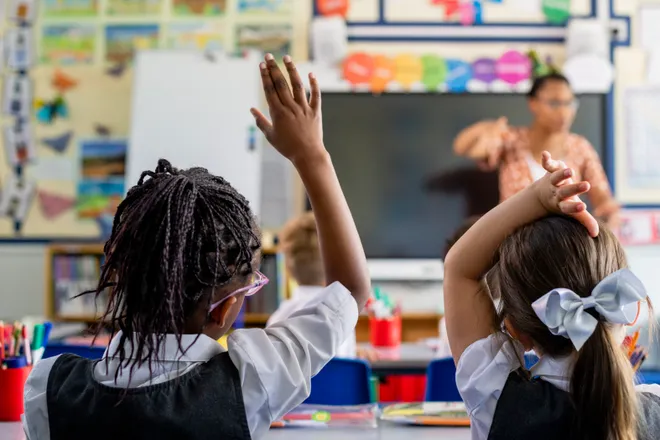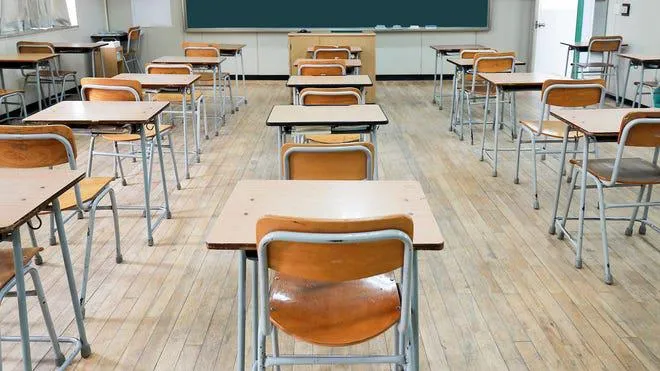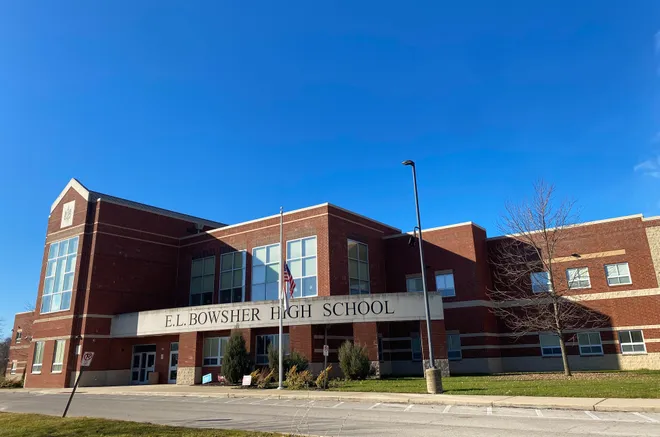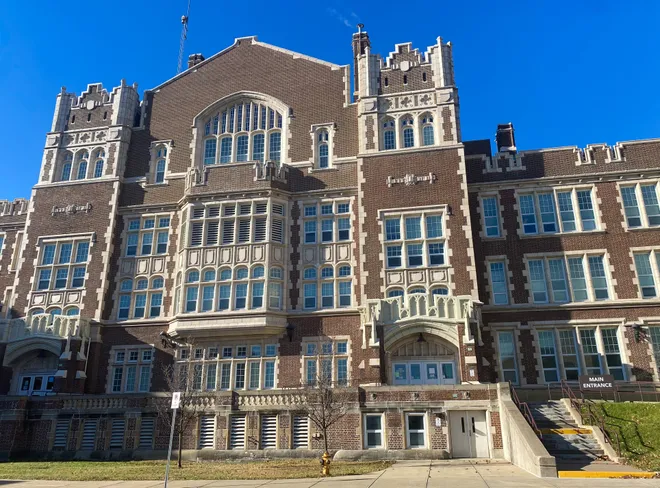‘It was the most unfair thing’: Disobedience, school discipline and racial disparity

TOLEDO, Ohio – The sound of his teacher smacking his desk jolted Marquan into consciousness, and his head jerked up. “Wake up,” his teacher said.
Marquan hadn’t slept much the night before, and the words came out before he was fully coherent. “Watch out before you make me mad,” he said.
His teacher turned and asked if that was a threat. The 16-year-old said no, he was just startled, but it was too late – he was sent out of the classroom and given a two-day suspension.
What the teacher heard as a threat was, for Marquan, an instinctive reaction, and he had failed to code-switch in that groggy moment.
“I wasn’t threatening him; it was just loud and all of a sudden,” said Marquan, now 17 and a sophomore at Jesup W. Scott High School in Toledo, Ohio. (His last name is being withheld to protect his privacy.) “That was the most unfair thing.”
In Ohio, Black students like Marquan are suspended for incidents like this far more frequently than their white peers. In the past six years, Ohio has issued close to 885,000 suspensions and expulsions for comments and misbehaviors tagged as disobedience or disruption. Nearly half of those dismissals have been for Black students, even though they make up only 17% of the public school population. Black students in Ohio are, on average, kicked out of classes for these offenses at four and half times the rate of white students.
A Hechinger Report analysis across 20 states found that in many of them, including Indiana, Maryland and Rhode Island, Black students are suspended more often for infractions that can include dress code violations, talking back to teachers and being too noisy in class.
Subjective terms lead to selective punishment
States use different terms to describe the offenses – disrespect, insubordination, defiance – depending on their discipline code. But what they all have in common is the subjective nature of an educator’s decision; experts say that’s what leads to racial disparities. What seems disrespectful and threatening in one classroom can be entirely acceptable in another, depending on who’s listening and who’s speaking. That’s when racial and cultural differences between educators and students can come into play. Bias also plays a role.
Researchers say that racial disparities inside schools tend to reflect what’s happening in society as a whole and that income level does not explain the discrepancies.
“Teachers are no more biased than other people, but also no less biased,” said Russell Skiba, a professor in the school psychology program at Indiana University and director of its Equity Project. “Race is the much more important predictor of whether a kid gets suspended rather than poverty.”
The Indiana Department of Education said that school discipline policies were set at the local level. Rhode Island said that it helps school districts in setting discipline policies that "are conducive to a safe and nurturing environment that promotes academic success." Maryland’s state education agency said only that it makes annual data available for school districts to analyze.
In Ohio, a spokesperson from the Department of Education and Workforce, Lacey Snoke, didn’t respond directly to questions about the state’s racial disparities. Snoke, the chief communications officer, said the department “supports schools and districts as they address non-academic barriers to learning.”
Snoke also noted that the state requires schools to use a student support system known as Positive Behavioral Interventions and Supports, or PBIS. “When implementing PBIS with fidelity, schools and districts see a reduction in out-of-school suspension and exclusionary discipline,” she said.
Like many of America’s school districts, Toledo’s public schools have struggled with keeping discipline racially equitable for years. In 2020, following a federal civil rights investigation, the district agreed to a settlement with the federal Department of Justice “to address and prevent discriminatory discipline of students based on race or disability.” Last spring, the government extended its monitoring for an additional year after finding that the district was not in full compliance with the settlement terms.
Root cause for disparities unclear
Part of the problem in Toledo, the fifth-largest school district in Ohio with more than 21,000 students, is that teachers and administrators haven’t figured out what’s at the root of the disparity, according to a federal monitoring report sent to the district last May and obtained by The Hechinger Report as part of its investigation into the widespread use of suspension for things like defiance and disruption around the country.
“Speculative answers about the reasons for why disciplinary referrals would be greater for Black students when compared to white students ranged from blaming the students’ underperformance in math and English language arts to blaming ‘parents who don’t take pride’ or are otherwise uninvolved in their children’s lives,” according to the report. “Educators at one school opined that they are not using strategies that engage kids of color; those at another school said they needed to develop activities for students to feel more of a sense of belonging.”

Last year, there were more than 12,000 suspensions in Toledo public schools for defiance or disruption and more than 7,700 were given to Black students, up from 7,000 the year before. Black students received 65% of defiance and disruption suspensions last year, even though they make up about 46% of the student population in Toledo.
The reason for the high numbers is multifaceted, and the solutions need to be as well, said Amerah Archer, acting executive director for the Department of Equity Diversity and Inclusion in the Toledo Public Schools.
“We understand there's sometimes a cultural mismatch between teachers and students and their backgrounds,” Archer said. “So we offer culturally responsive training, to help our teachers understand how to build relationships and students across cultures.”
The district has also brought in outside mental health providers and – in all 57 of its schools – it has set up social-emotional wellness teams to examine discipline data and look for trends, including racial disparities within schools and classrooms. Educators receive training on how to respond to students who have endured trauma and may be acting out as a result, with responses that can lead to alternatives to suspensions.
‘He just scares me’
Sheena Barnes, president of the school board until January this year, points to a culture that views some children as more dangerous than others. She’s also concerned about educators who have trouble appropriately interpreting a child’s behavior.
Barnes, who is Black, got a call last year to come to her child’s school immediately. Her son, who is on the autism spectrum and was in third grade at the time, had been trying to mix paints to make a specific color. The teacher accidentally took one of the colors away, frustrating the boy, who threw his paintbrush and splattered some paint. After Barnes arrived and helped de-escalate the situation, she said the teacher asked her if they could talk.
“'He just scares me,” she said the teacher confessed to her.
“So I asked her, ‘What did he do? Did he bite you, kick you, did he throw something at you, cuss at you? I’m going through all the list of things that could make you scared of a 9-year old, my baby.’ And she says, ‘It’s the way he looks at me.’
“And I just crumble,” Barnes recalled. “If you're scared of him in third grade, what the hell are you gonna do to him in ninth grade?”
Moments like these – when adults see children as threatening – can influence decisions made in a heated classroom situation. The Department of Justice report on Toledo schools last spring concluded that “subjective infractions that are prone to bias, such as ‘Disruptive Behavior’ and ‘Failure to Follow Directions’” play a role in racial discrepancies when it comes to discipline.

Toledo school officials noted that the report said that the district had “made significant progress” in some areas and that the COVID-19 pandemic had “hampered and delayed the District’s ability to execute certain provisions in a timely manner.”
Barnes, who remains on the school board, said she welcomed the continued monitoring by the government, because, she said, “we still have work to do.”
“There’s not a bad child – there’s a child reacting to a bad situation,” she said, sitting in a cafe in downtown Toledo, and noting the many serious issues faced by young people, such as gun violence and food insecurity.
“Maybe I can't read. So, I'm gonna disrupt the class, because I don't want to get embarrassed,” said Barnes. “Or if you ask me where my homework is, I'm gonna make some silly jokes and get kicked out, because I don't want people to know that I didn't have a home to sleep in last night, or I couldn't do my homework, because we didn't have power.”
Teacher experience, training key to prevention
Sometimes disruptive behavior starts with a small incident – like a student calling out in class. If a teacher has trouble redirecting the child, it can escalate, and the classroom can become chaotic. Teachers sometimes conclude that removing the child who is being loud is in the best interest of the whole class.
Experience and training can provide teachers with tools to address student conduct without suspensions.
One study in California published last year found that it was often the least-experienced teachers who relied on removing disruptive students from the classroom, and that even three years of teaching experience led to a substantial drop in the number of students referred for discipline.

The same study found that, among teachers who removed students from class and sent them to the principal’s office for disciplinary action, the top 5% did this so often that they accounted for most of the racial gaps in these referrals – effectively doubling those gaps.
Those gaps are largely driven by incidents that require a more subjective call, such as for “defiance,” rather than more objective categories like drug use or skipping class, according to Jing Liu, an assistant professor of education at the University of Maryland and one of the study’s authors.
Other researchers argue that stressful environments can bolster racial inequities.
“When people are stressed out, when they are under pressure, when they don’t have the time to think through a response, they are more likely to rely on racial biases,” said Juan Del Toro, a professor in the psychology department at the University of Minnesota, Twin Cities, who has studied the impact of discipline policies on Black students.
Del Toro argues that more support for teachers could bring down the number of suspensions for low-level offenses, which in turn could help more students perform well academically. His research showed that when students committed minor infractions, those who were suspended experienced significant negative academic consequences, compared with students who were just written up for the same kind of offense.

In Toledo, Jamarion, a 10th grader at E. L. Bowsher High School, was serving an in-school suspension last December for getting in an argument with another student when he was assigned an additional three days for talking in the suspension room.
“We were just talking about the way we were feeling, bored and all that. You’re just sitting there all day staring at the wall or doing your homework,” said Jamarion, who is 15. (His last name is being withheld to protect his privacy.) “You should at least get a warning or something.”
“It’s not fair,” he said. “I was mad, upset.” And he said he was concerned about missing more math classes and falling behind.
Educators say banning suspensions isn’t the solution
Educators and administrators emphasize that simply banning suspensions for low-level offenses would not change school culture or help educators find alternatives. “It could fix the data,” said Myree, the former Cincinnati principal, “but it might not fix what’s going on in the building.”
Some districts in Ohio, such as Cleveland Municipal, reduced the number of disobedience suspensions of Black children over the past year, but the number in Ohio overall climbed to more than 78,400 in 2022-23, up 16% from the previous year.

Izetta Thomas spent 18 years as an educator in Columbus public schools in Ohio and is now the education justice organizer for the Columbus Education Association, the union that represents Columbus educators.
She believes individual teachers have a responsibility for their actions, but that teacher-prep programs and the school system itself could do more to curb the overuse of suspensions.
“It’s hard for educators because a lot of us might feel like this [discipline decisions] is not what I signed up to do, this is not what I learned in my college classroom,” said Thomas. “But why isn’t it a part of teacher training in colleges? Why isn’t understanding of our own biases and lenses and those that are different from ours, why aren’t we taught early on what that is?”
“Everybody needs Band-Aids, she added, “but Band-Aids only last so long.”
CONTRIBUTING: Fazil Khan, The Hechinger Report
Note: The Hechinger Report'sFazil Khan had nearly completed the data analysis and reporting for this project when he died in a fire in his apartment building. USA TODAY Senior Data Editor Doug Caruso completed data visualizations for this project based on Khan’s work.
This story aboutracial disparities in school discipline was produced by USA TODAY publishing partnerThe Hechinger Report, a nonprofit, independent news organization focused on inequality and innovation in education.
Disclaimer: The copyright of this article belongs to the original author. Reposting this article is solely for the purpose of information dissemination and does not constitute any investment advice. If there is any infringement, please contact us immediately. We will make corrections or deletions as necessary. Thank you.






